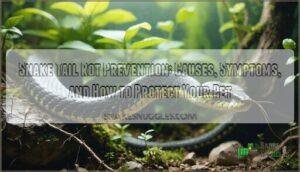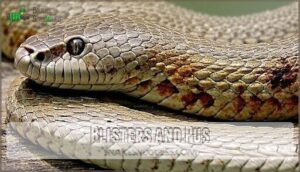This site is supported by our readers. We may earn a commission, at no cost to you, if you purchase through links.

Regularly clean the enclosure, as bacteria thrive in dirty or damp environments. Keep humidity and temperature within species-specific ranges—too much moisture or extreme temperatures can weaken your snake’s immune system.
Provide a balanced diet rich in essential nutrients to support overall health, and check for any injuries or stuck shed that could lead to infection.
Stress is another culprit, so minimize handling and create a calm environment. Prevention is key, but if you notice symptoms, act quickly—early intervention can save your snake from serious complications, and it is crucial to act with urgency to prevent serious damage.
Table Of Contents
- Key Takeaways
- Snake Tail Rot Causes
- Recognizing Scale Rot Symptoms
- Preventing Scale Rot Infection
- Creating Healthy Snake Environment
- Managing Snake Health Through Diet
- Effective Scale Rot Treatment
- Frequently Asked Questions (FAQs)
- How do you prevent tail rot?
- How to treat tail rot in snakes?
- How do you prevent mouth rot in snakes?
- Why does my snake keep getting scale rot?
- How do you treat scale rot on a snake?
- How do you treat corn snake scale rot?
- What happens if you don’t treat scale rot on a snake?
- What should I do if my reptile has scale rot?
- How do you treat a snake with eyecaps?
- How to fix tail rot in snakes?
- Conclusion
Key Takeaways
- Keep your snake’s enclosure clean, dry, and well-ventilated to prevent bacteria buildup and infections.
- Monitor humidity and temperature levels closely to avoid conditions that weaken your snake’s immune system.
- Provide a balanced diet rich in essential nutrients to strengthen your snake’s health and immunity.
- Inspect your snake regularly for injuries or shedding issues, and act quickly if you notice any signs of tail rot.
Snake Tail Rot Causes
Snake tail rot often starts with poor habitat conditions, unhygienic environments, or physical damage to the scales, creating an entry point for infections.
Poor habitat and hygiene can open the door to infections, making prevention the key to keeping your snake healthy.
Inadequate diets can also weaken your snake’s immune system, making it more vulnerable to this serious condition, and poor habitat conditions can exacerbate the issue.
Poor Habitat Conditions
Dirty enclosures and damp substrate create a breeding ground for bacteria, increasing the risk of scale rot.
Incorrect temperatures lead to wet bedding, while low temperatures and inadequate ventilation worsen unsanitary living conditions.
Overcrowding risks add stress, weakening your snake’s immune system.
To avoid scale rot, make certain proper ventilation, maintain dry bedding, and regulate temperature and humidity levels carefully.
Unhygienic Environment
An unclean environment invites trouble.
Unsanitary living conditions, like dirty substrate or feces buildup, foster bacteria growth and infections like scale rot. Poor ventilation and contaminated water worsen the problem, turning your reptile’s home into a health hazard.
Snakes are also vulnerable to scale rot causes when kept in unclean environments.
- Unchecked feces buildup can lead to rapid bacterial spread.
- Dirty substrate traps moisture, creating breeding grounds for germs.
- Infrequent enclosure cleaning jeopardizes reptile hygiene.
Inadequate Diet
Without proper nutrition, a snake’s immune system weakens, making it vulnerable to tail rot.
Vitamin deficiencies in their reptile diet can stunt growth, hinder organ function, and cause shedding issues.
Balanced feeding guarantees nutrient absorption and prevents immune weakening.
Supplement their needs with this guide:
| Key Nutrient | Impact on Health | Source Suggestions |
|---|---|---|
| Vitamin A | Skin health, shedding | Carrots, squash |
| Vitamin C | Wound healing, immunity | Bell peppers, broccoli |
| Calcium | Bone strength, organ support | Collard greens, kale |
Physical Damage to Scales
Physical damage to scales often comes from enclosure hazards, improper handling techniques, or shedding issues.
Abrasions or cuts can invite infections like snake tail rot. Prevent trauma by choosing smooth furnishings, maintaining safe handling habits, and monitoring for snake skin problems.
Regularly inspect for damaged scales, as untreated injuries may lead to scale rot. Careful snake care guarantees healthier, happier pets.
Recognizing Scale Rot Symptoms
Spotting scale rot early can save your snake from serious health complications, so it’s essential to know what to look for.
Watch for abnormal discoloration, raised or crusty scales, and unusual behaviors as these are often the first warning signs of serious health complications.
Discoloration of Scales
Spotting discolored scales is one of the early indicators of snake tail rot.
Abnormal scale coloration, such as red, rust, or brownish shades, often shows up in affected areas like the belly or tail.
This color progression can signal worsening severity levels.
A differential diagnosis helps confirm snake scale rot, so monitor these changes carefully, focusing on snake scale rot prevention.
Blisters and Pus
Blisters are early reptile scale rot symptoms, starting small but often filling with pus as a snake bacterial infection progresses.
These blisters signal infection stages that can lead to open lesions and tissue breakdown.
Without treatment or veterinary drainage, complications worsen, and effective care requires disinfecting blisters properly and closely observing changes to prevent scale rot from becoming severe.
Raised Scales and Blood Pooling
Raised scales often signal trouble, as scale elevation mechanics reveal blood pooling causes beneath the surface.
Early detection matters—tackling raised scales promptly can prevent worsening.
Look for these signs:
- Swollen scales with discoloration.
- Reddish-brown patches near the belly.
- Uneven textures, like peeling paint.
- Puffiness suggesting fluid.
Treat quickly to stop progression and keep your reptile thriving! One key indicator is discoloration of scales, signaling potential scale issues.
Behavioral Changes in Snakes
When a snake’s activity levels suddenly drop, or hiding behavior becomes excessive, it could signal tail rot.
Appetite loss and unexpected aggression increase are other red flags.
Watch for shedding changes too, as infections affect skin health.
Maintaining proper snake husbandry, including snake enclosure cleanliness, temperature, humidity, and diet, helps prevent these issues while keeping your pet calm, safe, and thriving.
Ensuring the right environment is crucial, and by doing so, you can prevent many problems, which is why proper snake husbandry is key.
Preventing Scale Rot Infection
You can prevent scale rot infections by keeping your snake’s enclosure clean, dry, and properly maintained.
Monitor humidity and temperature levels closely, and provide a balanced diet to support your pet’s overall health.
Regular Cleaning of Enclosure
Keeping your snake’s enclosure clean is essential to their health. Regularly remove feces and replace the substrate to prevent bacterial growth.
Disinfecting supplies and proper water sanitation are key. Make certain good ventilation to maintain dryness and eliminate odors.
Consistent snake enclosure cleaning builds a safer habitat, promoting hygiene and reducing the risk of infections like scale rot. Use appropriate cleaning supplies for superior hygiene.
Maintaining Proper Temperature
Proper enclosure cleaning paves the way for another essential aspect—temperature control. Consistent warmth helps prevent tail rot, especially for species temperature needs.
Use tools to monitor reptile temperature and set a basking spot temp (85-90°F). A key element is using the correct basking bulb for proper heating.
- Avoid nighttime temperature drops below 70°F.
- Use safety-checked heating elements.
- Provide a gradient for choices.
- Regularly inspect your reptile enclosure.
Regulating Humidity Levels
Balancing temperature helps prevent rot, but humidity management shields your snake’s skin.
Use a reliable reptile humidity gauge to keep levels ideal, typically 40-60%, depending on species. You can find a reptile humidity gauge at many online retailers.
Proper substrate choice and ventilation importance play a big role, aiding breathability and moisture balance.
Seasonal adjustments matter too—during shedding, slightly increase humidity as a shedding aid, ensuring reptile scale rot humidity stays in check.
Providing Balanced Diet
Just like managing humidity, offering a balanced snake diet boosts reptile health.
Focus on nutrient absorption by ensuring prey quality matches your snake’s dietary needs.
Food variety helps prevent vitamin deficiency, while proper hydration supports digestion.
Keep an eye on supplementation needs for gaps in the reptile diet, and remember a healthy diet strengthens immunity and guards against scale rot.
Creating Healthy Snake Environment
Creating a healthy environment for your snake is key to preventing tail rot and other health issues.
By focusing on proper bedding, clean water, and minimizing stress, you can guarantee your pet stays safe and comfortable.
You can ensure the overall well-being of your snake by following these guidelines.
Choosing Appropriate Bedding
Your snake’s bedding plays a huge role in their health and comfort.
Choose wisely by considering these factors:
- Aspen or cypress mulch: Great absorbency and reptile-safe.
- Paper towels: Cost-effective and ideal for snake hygiene.
- Coconut husk: Maintains proper humidity.
- Avoid pine or cedar: Toxic for reptiles.
- Clean frequently: Keeps enclosure cleanliness and prevents scale rot.
To further enhance their habitat, consider adding live plants for sustainability.
Pick bedding for safety and reptile prevention, ensuring a reptile-safe environment.
Maintaining Clean Water and Food
Every day, keep your snake’s water fresh and clean to maintain water source hygiene and support snake health.
Scrub food bowls regularly to guarantee food bowl sanitation and avoid bacterial buildup.
Monitor water quality to prevent spillage that could dampen the enclosure, and practice safe food handling for reptile care, promoting enclosure cleanliness and reducing the risk of infections like scale rot.
Reducing Stress in Snakes
Give your snake a calm, secure home to reduce stress.
Add hiding places for privacy and use proper lighting to mimic natural cycles. Handle them gently, avoiding overhandling to maintain good snake health.
Enclosure enrichment like climbing branches and the right snake substrate helps too. Monitor snake temperature and humidity to guarantee ideal reptile care.
Managing Snake Health Through Diet
Feeding your snake a balanced diet rich in essential vitamins and minerals is key to preventing health issues like tail rot.
By ensuring your pet gets proper nutrition, you can strengthen its immune system and support overall well-being.
Providing Essential Vitamins and Minerals
A balanced diet guarantees peak reptile health and helps prevent deficiency symptoms.
Prioritize these key Vitamin Sources and Supplementation Methods:
- Dust prey with calcium powder for strong bones.
- Provide D3 supplements if UVB lighting is absent.
- Use multivitamins weekly for dietary balance.
- Include mineral-rich greens sparingly.
- Consult a reptile care guide for species-specific needs.
Good nutrition is essential for scale rot prevention!
Avoiding Nutrient Deficiencies
Last time, we talked about vitamins boosting your snake’s well-being. Neglecting nutrients, though, can throw reptile health off balance.
Keep your snake’s gut health strong by gutloading prey with quality nutrients. Pair this with a hydration plan and vitamin supplementation. Balanced meals aren’t just trendy—they’re critical for snake care.
Recognizing signs of malnutrition is essential for early intervention. Here’s a quick guide:
| Nutrient | Benefits | Sources |
|---|---|---|
| Vitamin A | Eye & skin health | Liver, gutloaded insects |
| Vitamin D3 | Bone strength | Supplements, sunlight |
| Calcium | Bone and muscle support | Calcium dust, small rodents |
| Omega-3 Fatty Acids | Immune support | Prey gutloading |
| Hydration | Overall health | Clean water, moisture-rich prey |
Feeding Snakes a Balanced Diet
A varied snake diet with properly sized prey supports reptile nutrition while preventing obesity.
Stick to a feeding schedule matching your snake’s needs, enhancing prey variety for better health.
Include occasional supplementation needs, based on a vet’s advice. Hydration is critical too—clean water guarantees balance.
A reptile scale rot diet focuses on avoiding deficiencies and strengthening immunity. A varied snake diet with properly sized prey supports reptile nutrition while preventing obesity.
Effective Scale Rot Treatment
To effectively treat scale rot, you’ll need to start by isolating your snake and cleaning the affected area with care.
Combining proper wound care, antibiotic treatments, and guidance from a reptile veterinarian guarantees the best chance of recovery.
Quarantine and Isolation
Quarantine’s your first line of defense when dealing with scale rot or new arrivals.
Set up an isolation setup in a separate, sterile enclosure to prevent spread. Stick to strict monitoring protocols during the reptile quarantine, checking daily for symptoms.
A two-week quarantine length works for most snakes but extend as needed.
Pet isolation protects your reptile collection from infections, and a quarantine is essential for preventing the spread of disease, making strict monitoring crucial, and daily checks are necessary to ensure the health of your pets.
Antibiotic Treatment
To treat reptile bacterial infections, antibiotics play a critical role.
Consult a reptile veterinarian to determine the right type, dosage, and duration. For mild cases, apply antibiotic spray or ointments twice daily.
Monitor progress closely to avoid resistance concerns. Severe infections may require oral or injectable antibiotics prescribed by a snake vet.
Follow professional advice for best results.
- **
Wound Care and Cleaning
Proper snake wound care requires consistent cleaning and monitoring.
Use antiseptic solutions like Betadine baths or chlorhexidine solutions for treating infected areas daily.
Apply topical medications carefully, avoiding the snake’s eyes and mouth.
Scale hydration is essential, but keep the habitat dry to prevent re-infection.
Increase cleaning frequency of the enclosure to maintain hygiene during wound treatment.
Veterinary Consultation and Guidance
Your snake’s health is worth expert attention.
A reptile veterinarian provides a precise diagnosis, exploring treatment options like medication guidance or, if needed, surgical intervention.
Regular follow-up care confirms recovery is on track.
Reptile veterinary care helps prevent worsening conditions, giving snakes the best chance to heal.
Tusting a snake veterinarian is key for effective reptile scale rot treatment.
Frequently Asked Questions (FAQs)
How do you prevent tail rot?
Think of prevention like building a fortress—keep enclosures clean, dry, and well-ventilated.
Monitor humidity, avoid damp bedding, and inspect regularly.
Balanced nutrition and proper temperatures strengthen your snake’s defenses against tail rot, which is a key part of prevention and building a strong defense.
How to treat tail rot in snakes?
Isolate your snake in a clean, dry enclosure, gently clean the affected area with a diluted Betadine solution, and apply antibiotic ointment.
Raise enclosure temperatures slightly, and consult a reptile vet for severe cases.
How do you prevent mouth rot in snakes?
An ounce of prevention beats a pound of cure—keep your snake’s enclosure clean, control humidity, and provide proper temperatures.
Inspect their mouth regularly, offer a balanced diet, and address injuries promptly to avoid infections.
Why does my snake keep getting scale rot?
Your snake might keep getting scale rot due to damp bedding, poor enclosure hygiene, or incorrect humidity levels.
Make certain a clean, dry habitat, proper ventilation, and regular inspections to catch early signs and prevent recurrence.
How do you treat scale rot on a snake?
Picture a leaky roof—ignoring it only worsens the damage.
Treat scale rot by cleaning with Betadine, applying antibiotic ointment like Neosporin, and ensuring a dry, warm enclosure.
Consult a vet for severe cases.
How do you treat corn snake scale rot?
Treat corn snake scale rot by cleaning the infected area with diluted Betadine, applying antibiotic ointment like Neosporin, and keeping the enclosure warm, dry, and clean.
Consult a reptile vet for severe or persistent cases.
What happens if you don’t treat scale rot on a snake?
Scale rot, like a spreading wildfire, can consume your snake’s health if ignored.
Untreated, it leads to severe infections, tissue decay, and even death.
Act quickly—early care can mean the difference between recovery and tragedy.
What should I do if my reptile has scale rot?
If your reptile has scale rot, isolate it immediately.
Clean the enclosure thoroughly, and treat affected areas with Betadine or antibiotic ointments.
Consult a reptile vet for severe cases, ensuring proper humidity and temperature adjustments, and follow their advice for the best treatment.
How do you treat a snake with eyecaps?
Think of stuck eyecaps as nature’s stubborn bandaid.
Soak your snake in lukewarm water for 15-20 minutes, then gently rub the eyecap with a damp cotton swab.
If it persists, consult a vet.
How to fix tail rot in snakes?
Start by isolating your snake in a clean, dry enclosure.
Clean the affected tail with Betadine, apply antibiotic ointment like Neosporin, and monitor closely.
Severe cases need immediate vet attention for possible debridement or antibiotics.
Conclusion
Who knew a clean, cozy snake home could mean the difference between a happy pet and a health crisis?
Snake tail rot prevention isn’t rocket science—just stick to the basics.
Keep their habitat spotless, regulate humidity and temperature, and feed them a balanced diet.
Pay attention to signs of trouble, like discoloration or blisters, and act fast if needed to prevent a health crisis.
With consistent care, you’ll protect your slithery friend from harm and keep them thriving for years.


















